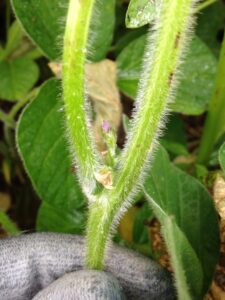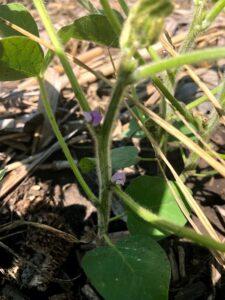Illinois farmers have done an excellent job shifting their mindset from planting corn first and then soybeans, to soybeans need to go in the ground early, usually prior to corn. Early soybean planting allows the bean plants to accumulate more vegetative growth, which leads to more nodes or additional locations for pods to set, and a longer period in the seed fill stages, all in turn increasing yields. Soybeans that are planted by mid-May usually begin to flower prior to the summer solstice, June 21. As we all know, this year’s spring did not allow for early planting dates so with the summer solstice looming in the near future, a couple questions may be worth a wonder. How does planting date affect flower date? Does flower date impact yield potential? As majority of the soybeans across the state are still in their early vegetative growth stages and the longest day of the year being only two weeks away, many fields of soybeans will be gearing up to transition from vegetative growth to reproductive.
How does planting date affect soybean flowering? Soybean flowering is induced by shorter days or longer nights. An old rule of thumb is that flowers do not begin to flower until after the summer solstice. We have all seen flowers prior to June 21 though in the past, especially in early planted soybeans. When early planted beans experience several nights longer than the critical length before the 21st, floral induction and flowering may occur sooner. Along with photoperiod, temperature plays a large role in flower growth. The warmer the temperatures, the faster flower growth will occur. Therefore, a warm spring or a spring with later plantings will hasten flowering within the soybean crop as well. It is looking like the number of days between planting and R1 for this year will be shortened due to the later planting and the seasonable temperatures.
 When soybeans flower, the plants enter the reproductive growth stages, so the plant allocates more energy into the flowering, seed formation, and seed fill instead of the vegetative growth. As the transition occurs from vegetative to reproductive, soybeans with later plantings will have less nodes on average compared to earlier planted beans. A shortened time between planting and R1 could have a possible negative impact on yield due to the fewer nodes. To overcome a lower node/acre count, an increased seeding rate needs to be utilized. If that recommendation is followed, a reduced vegetative growth period will have little to no negative impact on yields.
When soybeans flower, the plants enter the reproductive growth stages, so the plant allocates more energy into the flowering, seed formation, and seed fill instead of the vegetative growth. As the transition occurs from vegetative to reproductive, soybeans with later plantings will have less nodes on average compared to earlier planted beans. A shortened time between planting and R1 could have a possible negative impact on yield due to the fewer nodes. To overcome a lower node/acre count, an increased seeding rate needs to be utilized. If that recommendation is followed, a reduced vegetative growth period will have little to no negative impact on yields.
University of Illinois has created models that estimate a 10 percent increase in late planting (defined as after May 25) will reduce soybean yield by 0.5 bushels. However, weather, especially August/September rains, play the biggest role in making or breaking soybean yields. Take 2012 for example, planting season went well and was wrapped up in a timely manner, but it turned dry and yields were less than optimal. Even though planting this year spanned through the middle to late planting window, there is still hope to be had for a successful crop year!
Sources:


 and then
and then